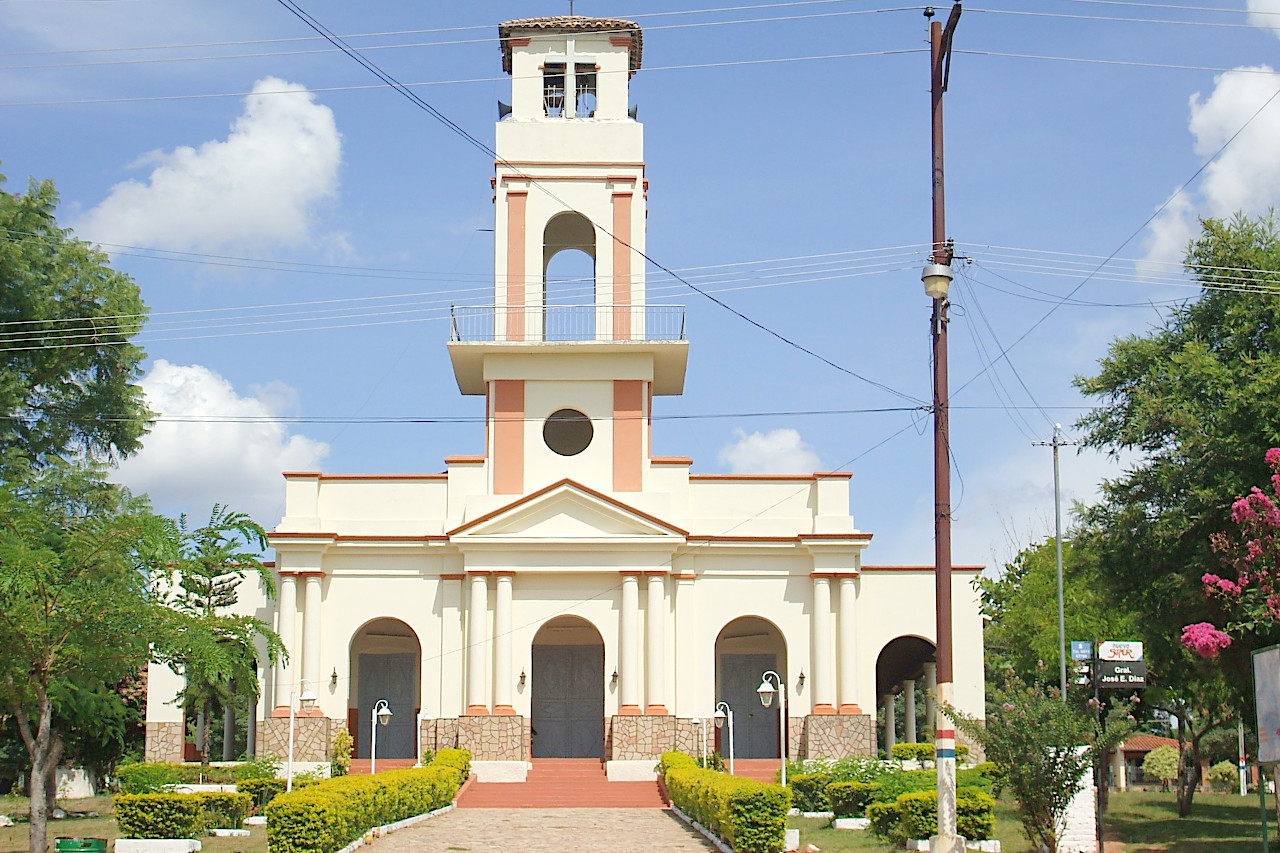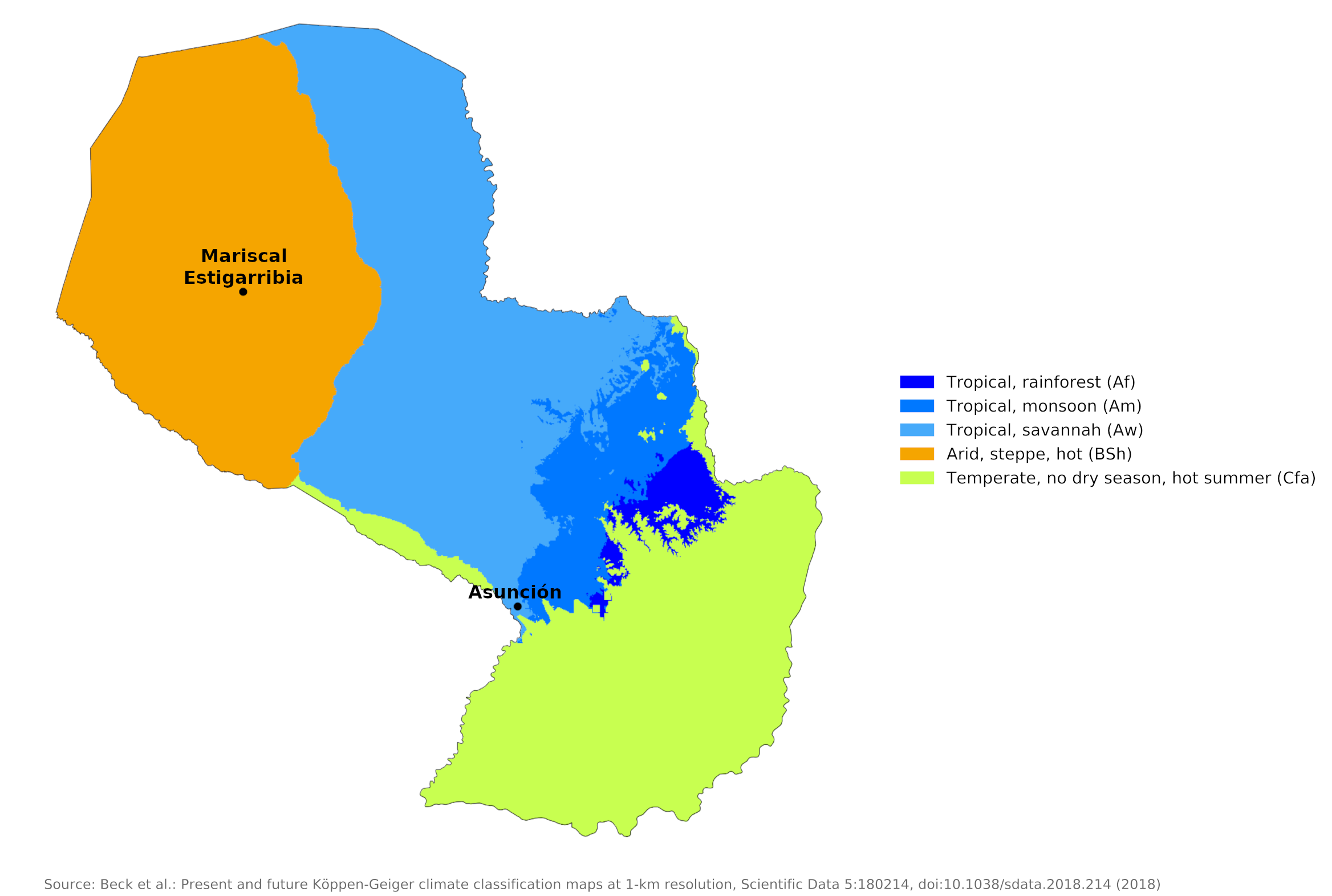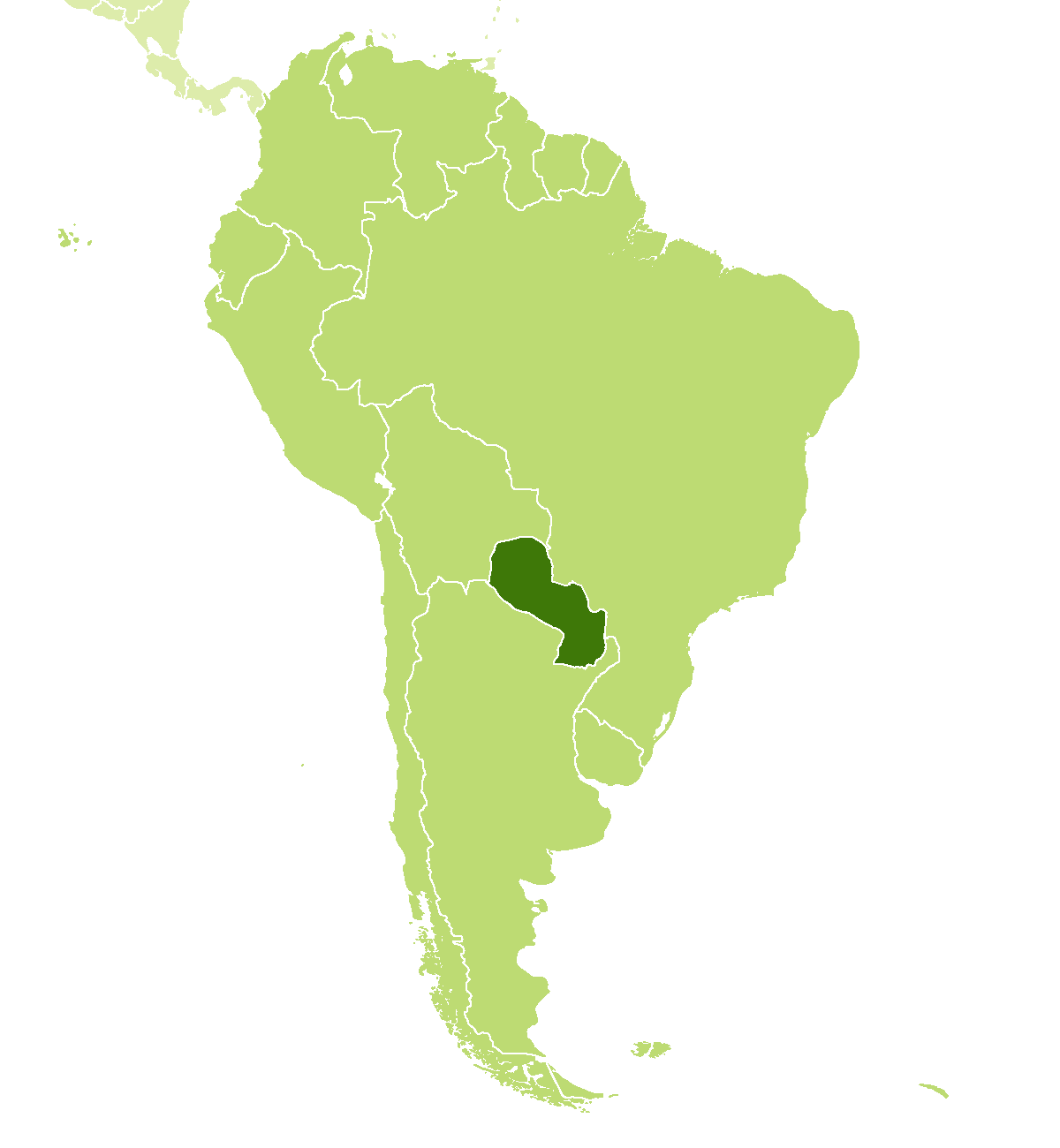The Climate of
Paraguay
 Iglesia de Atyra, Cordillera Department
Iglesia de Atyra, Cordillera Department
Climate Map
 Climate map of Paraguay
Climate map of Paraguay
What is the climate of Paraguay like?
Paraguay is entirely landlocked and is situated between 18° and 28°S. It is as large as the state of California. It is bordered on the north by Bolivia and Brazil and on the south by Argentina. Most of the country lies below 450 meters (1,500 feet). The northwestern part of the country—(Paraguay Occidental) and known as the Chaco—lies entirely within the tropics and has a typical tropical climate with hot summers, warm winters, and most of its rainfall in the hottest months between October and March. The southeastern half of the country—(Paraguay Oriental) and known as the Paraneña region—has temperatures a little lower in all months, but the summers are sufficiently hot and wet to be typically tropical.
There are basically two seasons: summer (October through March) and winter (May through August), with April and September serving as transitional months. Average summer temperatures range from about 25°C (77°F) to 38°C (100°F). Summer highs in the east usually do not rise much above 32°C (90°F), whereas highs in the west can top 43°C (109°F). Average winter temperatures are usually between about 16°C (60°F) and 21°C (70°F).
Rainfall is between 1,250 and 1,750 millimeters (50 to 70 inches) a year and it increases eastwards. Rain can be expected on about one day in five in winter and on about one day in three in summer. Asunción illustrates conditions in the centre of the country. To the northwest, in the Chaco, conditions are a little hotter in all months and there is less rainfall. In the southeast of the country it is rather wetter with slightly lower temperatures in all months. The southeast is the most developed and densely populated part of Paraguay.
Eastern Paraguay (the Paraneña)
Eastern Paraguay—the Paraneña region—is humid, with abundant rainfall throughout the year and only moderate seasonal temperature variations. During the summer, from October to March, the dominant influence on the climate is the warm sirocco wind blowing from the northeast. In winter, the prevailing wind is the cold pampero from the South Atlantic, which blows over Argentina and is deflected northeast by the Andes in the southern part of the country. Due to Paraguay's lack of mountain barriers, these opposing prevailing winds cause abrupt and erratic changes to the normally temperate weather. The winds are generally brisk.
The Paraneña region has only two distinct seasons: summer from October to March and winter from May to August. April and September are transitional months when temperatures are below mid-summer averages and low temperatures can drop below freezing. In terms of climate, autumn and spring don't really exist. During the mild winters, July is the coldest month with an average temperature of about 18°C (64°F) in Asuncion. There is no north-south variation worth mentioning.
The number of days of below-freezing temperatures ranges from as few as three to as many as sixteen per year, and with even larger variations deep inland. Some winters are very mild, with winds constantly blowing from the north and little frost. However, during a cold winter, Antarctic air blasts bring temperatures below freezing to all areas. No part of the Paraneña region is completely frost-free, and snow flurries have been reported in various locations.
Moist tropical air keeps the weather in the Paraneña region warm from October to March. In Asunción, the seasonal average is around 25°C (77°F), with January, the warmest month, averaging 28°C ( 82°F). Daytime temperatures of up to 38°C (100°F) are fairly common in summer. However, frequent cool air waves from the south make for weather that alternates between clear, humid conditions and storms. The sky will be almost clear for a week to ten days as temperature and humidity rise continuously. As the muggy heat nears unbearable limits, thunderstorms will roll in ahead of a cold front from the south and temperatures will drop by as much as 15°C (25°F) within a few minutes.
Rainfall in the Paraneña region is fairly evenly distributed. The least rain falls in July. Average annual rainfall is about 1,250 millimeters (50 inches), although it increases eastward. All areas can experience significant fluctuations from year to year.
| Climate data for Asunción (1971–2000) | |||||||||||||
|---|---|---|---|---|---|---|---|---|---|---|---|---|---|
| Month | Jan | Feb | Mar | Apr | May | Jun | Jul | Aug | Sep | Oct | Nov | Dec | Year |
| Average high °C (°F) | 33.5 (92.3) | 32.6 (90.7) | 31.6 (88.9) | 28.4 (83.1) | 25.0 (77.0) | 23.1 (73.6) | 23.2 (73.8) | 24.8 (76.6) | 26.4 (79.5) | 29.2 (84.6) | 30.7 (87.3) | 32.3 (90.1) | 28.3 (82.9) |
| Daily mean °C (°F) | 27.5 (81.5) | 26.9 (80.4) | 25.9 (78.6) | 22.8 (73.0) | 19.8 (67.6) | 17.9 (64.2) | 17.6 (63.7) | 18.6 (65.5) | 20.5 (68.9) | 23.2 (73.8) | 24.8 (76.6) | 26.5 (79.7) | 22.7 (72.9) |
| Average low °C (°F) | 22.8 (73.0) | 22.3 (72.1) | 21.3 (70.3) | 18.6 (65.5) | 15.7 (60.3) | 13.8 (56.8) | 13.1 (55.6) | 14.3 (57.7) | 15.9 (60.6) | 18.6 (65.5) | 20.1 (68.2) | 21.8 (71.2) | 17.9 (64.2) |
| Average precipitation mm (inches) | 147.2 (5.80) | 129.2 (5.09) | 117.9 (4.64) | 166.0 (6.54) | 113.3 (4.46) | 82.4 (3.24) | 39.4 (1.55) | 72.6 (2.86) | 87.7 (3.45) | 130.8 (5.15) | 164.4 (6.47) | 150.3 (5.92) | 1,401.2 (55.17) |
| Source: World Meteorological Organization | |||||||||||||
Western Paraguay (the Chaco)
Northwest Paraguay is part of the Chaco region, which extends into the bordering regions of Bolivia and Argentina. In contrast to the Paraneña region, the Chaco has a tropical wet-dry climate that borders on semi-arid. The Chaco experiences seasons that alternately flood and dry the land, but seasonal temperature variations are small. Chaco temperatures are typically high, with average temperatures falling only slightly during winter. Even at night, the air is stuffy, despite the usual breezes.
Precipitation is light, varying between 500 and 1,000 millimeters (20 to 40 inches) per year, except at higher elevations in the northwest where it is slightly greater. Rainfall is concentrated in the summer months, and vast areas that are deserts in winter become swamps in summer. Rainwater evaporates very quickly.
Occasional bursts of colder polar air from Antarctica hit the region in winter; This cold air lowers the temperature for about a day, but frost is very rare. This is a sparsely populated region. It is very flat and level; The elevation of the country increases very gradually towards the Bolivian border. Climate and weather differences are small in the Chaco. The weather can often be downright muggy and oppressive during the wet summer months, and this is particularly so in the Chaco region.
| Climate data for Mariscal Estigarribia | |||||||||||||
|---|---|---|---|---|---|---|---|---|---|---|---|---|---|
| Month | Jan | Feb | Mar | Apr | May | Jun | Jul | Aug | Sep | Oct | Nov | Dec | Year |
| Average high °C (°F) | 35.3 (95.5) | 34.6 (94.3) | 33.4 (92.1) | 30.5 (86.9) | 27.2 (81.0) | 25.2 (77.4) | 26.4 (79.5) | 28.9 (84.0) | 31.1 (88.0) | 34.0 (93.2) | 34.6 (94.3) | 35.1 (95.2) | 31.4 (88.5) |
| Daily mean °C (°F) | 28.7 (83.7) | 28.0 (82.4) | 26.9 (80.4) | 24.0 (75.2) | 21.3 (70.3) | 18.9 (66.0) | 19.3 (66.7) | 21.3 (70.3) | 23.6 (74.5) | 26.6 (79.9) | 27.7 (81.9) | 28.4 (83.1) | 24.6 (76.3) |
| Average low °C (°F) | 22.7 (72.9) | 22.1 (71.8) | 21.3 (70.3) | 18.4 (65.1) | 16.0 (60.8) | 13.7 (56.7) | 13.0 (55.4) | 14.3 (57.7) | 16.7 (62.1) | 19.7 (67.5) | 21.0 (69.8) | 22.1 (71.8) | 18.4 (65.1) |
| Average precipitation mm (inches) | 116.5 (4.59) | 98.1 (3.86) | 119.7 (4.71) | 77.8 (3.06) | 37.5 (1.48) | 18.8 (0.74) | 14.2 (0.56) | 21.7 (0.85) | 16.9 (0.67) | 52.9 (2.08) | 83.7 (3.30) | 119.2 (4.69) | 777.0 (30.59) |
| Source: NOAA | |||||||||||||
References
- E. A. Pearce, Charles Gordon Smith, (1990) The Hutchinson World Weather Guide, John Murray Press. ISBN 1859863426
- Timothy L. Gall, (ed.), (2003), Worldmark Encyclopedia of the Nations, Eleventh Edition, Thomson Gale
- Federal Research Division, Library of Congress, (1990), Paraguay: a country study. Claitor's Pub. Division.
- Hugh Chisholm, (ed.), (1911), Encyclopædia Britannica, Eleventh edition, Cambridge University Press
The Climate of
Paraguay

In summary:
The climate of Paraguay varies from tropical to subtropical. There are basically two seasons: summer (October through March) and winter (May through August). Average summer temperatures range from about 25°C (77°F) to 38°C (100°F). Average winter temperatures are usually between about 16°C (60°F) and 21°C (70°F).
Rainfall is heaviest in the east, where it averages over 1500 mm (60 inches) annually, decreasing to about 1250 mm (50 inches) in the lowlands of the Paraguay River, and about 750 mm (30 inches) in the Chaco region in the west. There is no definite rainy season, more rain falls in the summer months, but rainfall is rather irregular.